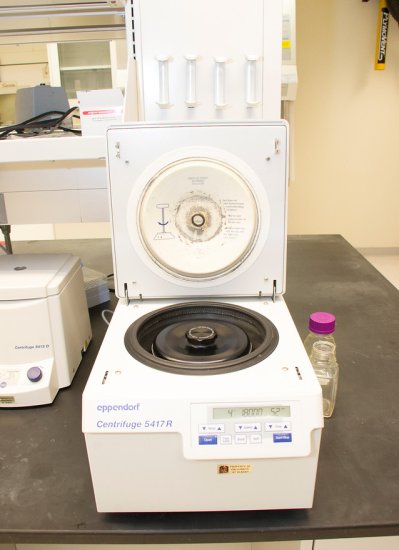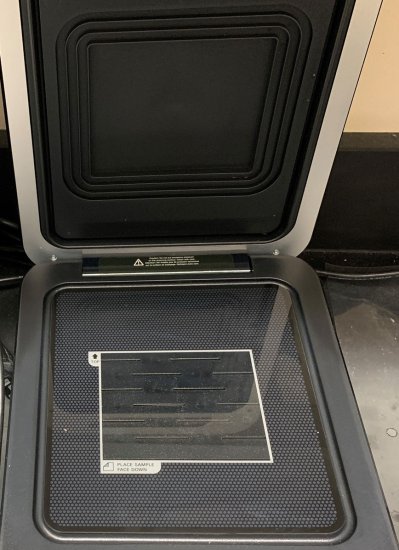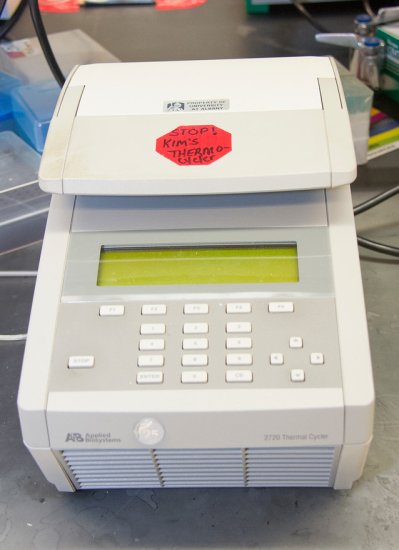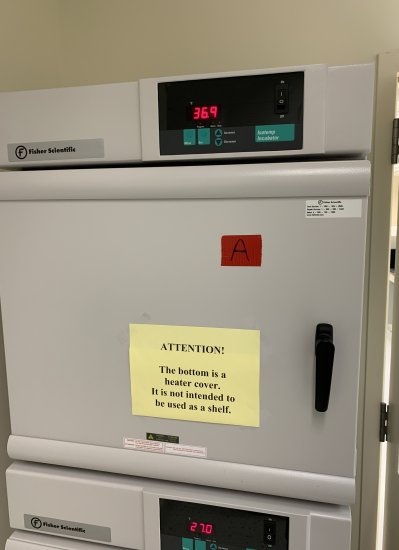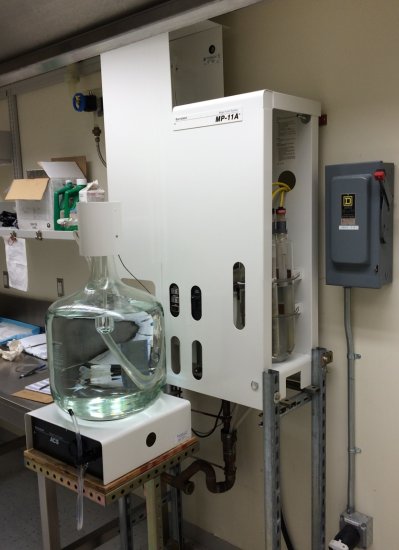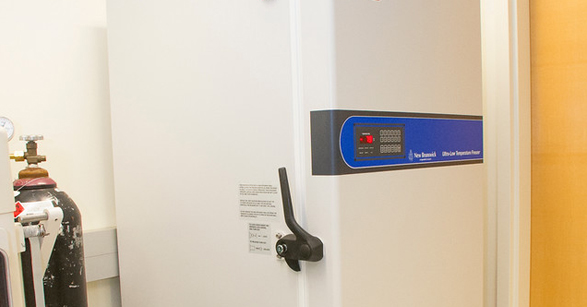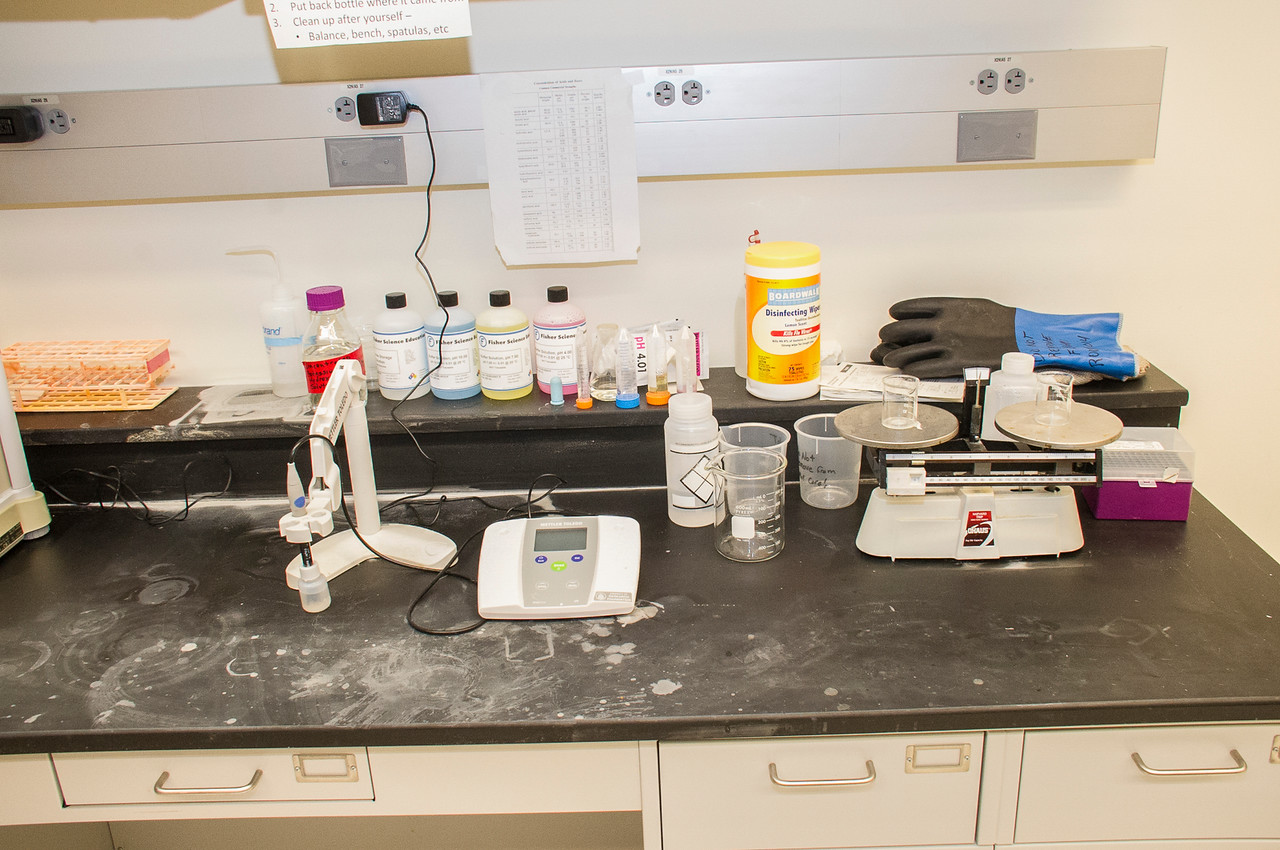The Molecular Core Facility can be accessed by the next generation of molecular scientists anytime and its instrumentation are used extensively by graduate students, post-docs, and research staff. Our philosophy is to keep the core facilities as comprehensive and accessible as possible to increase faculty, staff and student research productivity. The Molecular Core Facility provides maintenance, scheduling and training on instrumentation and also provides DNA sequencing services to investigators at the University at Albany.
Equipment
For access or consultation, contact Dr. Kim DeWeerd at 518-591-8831 or [email protected].
Scroll this page and learn more about our equipment use by clicking on the links below:
The Molecular Core Facility has two Beckman-Coulter Avanti J-E Centrifuges.
Purpose
Centrifugation is a process where samples are spun at very high speeds to create gravitational forces (g force) great enough to precipitate cells, organelles and insoluble components in a mixture.
Specific Description
These floor model centrifuges are used for medium speed centrifugation. Volumes from less than 10 milliliters up to 3 liters can be prepared in these centrifuges depending on the rotor used.
Available Rotors in the Molecular Core Facility
| Rotor | Max (rpm) | Max (g force) | Tube/bottle size | Capacity |
|---|---|---|---|---|
|
Fixed Angle Rotors |
||||
|
JA-10 |
10,000 |
17,000 |
2500 ml |
6 |
|
JA-12 |
12,000 |
17,400 |
50 ml |
12 |
|
JA-14 |
14,000 |
18,900 |
250 ml |
6 |
|
JA-20 |
20,000 |
31,400 |
50 ml |
8 |
|
JA-20.1 |
20,000 |
47,900 |
15 ml |
32 |
|
JA-25.5 |
25,000 |
51,200 |
50 ml |
8 |
|
Swinging Bucket Rotors |
||||
| JS-13.1 | 13,000 | 17,200 | 50 ml | 6 |
More Information
Avanti JE Operation Manual
The Molecular Core Facility has three Optima Ultracentrifuges. Two floor models: Optima LE-80K, Optima L-90K and one tabletop model; Optima TLX.
Purpose
Ultracentrifugation is a process where samples are spun at extremely high speeds to create gravitational forces (g force) great enough to separate membranes from soluble cell components, isolate organelles, and run gradients for separating DNA molecules, RNA and small cellular particles.
Specific Description
These floor model ultracentrifuges are used for high speed centrifugation. Volumes from less than 0.5 milliliters up to 472 milliliters can be prepared in these centrifuges depending on the rotor used.
Available Rotors in the Molecular Core Facility
| Rotor | Max (rpm) | Max (g force) | Tube Volume | Capacity |
|---|---|---|---|---|
|
Fixed Angle Rotors |
||||
|
60Ti |
60,000 |
485,000 |
4 ml |
6 |
|
70Ti |
70,000 |
361,000 |
39 ml |
8 |
|
90Ti |
90,000 |
503,000 |
13.5 ml |
8 |
|
TLA-120.1 |
120,000 |
513,000 |
0.5 ml |
14 |
|
TLA 120.2 |
120,000 |
513,000 |
1 ml |
10 |
|
VTi 65.1 |
65,000 |
363,000 |
13.5 ml |
8 |
|
VTi 65.2 |
65,000 |
385,000 |
5.1 ml |
16 |
|
Swinging Bucket Rotors |
||||
|
SW 28 |
28,000 |
107,000 |
38.5 ml |
6 |
|
SW 40Ti |
40,000 |
202,000 |
14 ml |
6 |
|
SW-41Ti |
41,000 |
207,000 |
13.2 ml |
6 |
|
TLS-55 |
55,000 |
201,000 |
2.2 ml |
4 |
More Information
Optima LE-80K Operation Manual
Optima L-90K Operation Manual
Optima TLX Operation Manual
The Molecular Core Facility has three refrigerated clinical centrifuges (Eppendorf 5810R) and one clinical centrifuge without refrigeration (5810).
Purpose
Clinical centrifuges are used for a variety of separations, but primarily to pellet cells from medium using relatively low g forces (3220 x g). Another common use is to spin membrane devices that separate macromolecules based on size.
Specific Description
These centrifuges are equipped with swinging bucket holders that accommodate either 4 round or 4 rectangular shaped holders. The rectangular shaped holders can be used to spin multi-well plates, 15 ml culture tubes or 50 ml culture tubes. The round holders are used to spin either 15 ml culture tubes or 50 ml culture tubes. Each rectangular holder can support three 50 ml tubes, nine 15 ml tubes or one multi-well plate. Each round holder can support seven 50 ml tubes or fourteen 15 ml tubes.
More Information
Eppendorf 5810 Centrifuge Manual
The Molecular Core Facility has two refrigerated microfuges (Eppendorf 5417R) and five microfuges without refrigeration (Eppendorf 5415D).
Purpose
A microfuge is a workhorse type of centrifuge used for a variety of separations in small volumes typical of Molecular Biology. The maximum centrifugal force in these centrifuges is 16,000 x g.
Specific Description
These centrifuges are equipped with fixed angle rotors that accommodate either 24 or 30 in non-refrigerated or refrigerated microfuges, respectively. The rotors can hold either 2.0 ml vials, 1.5 ml vials, 0.5 ml vials or 0.2 ml vials with adapters.
More Information
Eppendorf 5415D Centrifuge Manual
Eppendorf 5417R Centrifuge Manual
The Molecular Core has a Nanodrop Spectrophotometer ND-1000 and a Nanodrop Fluorospectrometer ND-3300.
Purpose
Many of the reactions that are set up in a Molecular Biology Laboratory are in very small volumes because reagents are very expensive and sample sizes are miniscule. The Nanodrop Spectrophotometer or Fluorospectrometer is designed to measure absorbance or fluorescence, respectively of molecules in very small liquid volumes (~1 μl).
Specific Description
The Nanodrop Spectrophotometer is used primarily to measure DNA, RNA or protein concentrations in the UV/visible light range. It can be used to measure absorbance spectra or single wavelengths of these macromolecules in solution. The software has algorithms that automatically calculate DNA, RNA or protein concentrations from the measured absorbance. It also has algorithms for specific colorimetric assays for protein such as Bradford, Pierce or Lowry assays.
The Nanodrop Fluoro-spectometer is used to measure fluorescent molecules in the 400 – 750 nm range. Samples are irradiated with one of three LEDs. The UV LED excitation spectrum has a maximum at 350 nm with a filter removing wavelengths longer than 400 nm. The Blue LED excitation spectrum has a maximum at 470 nm with a filter removing wavelengths longer than 495 nm. The White LED produces an excitation range from 500-600 nm and uses a virtual filtering method to quantify emission spectrum from molecules fluorescing at longer wavelengths.
More Information
ND-1000 Spectrofluorimeter Manual
ND-3300 Fluorospectrometer Manual
The Molecular Core has two BioRad Chemidoc MP imagers and a Licor C-Digit imager.
Purpose
Many of the steps involved in the isolation or identification of specific macromolecules requires separation and isolation procedures on gels or blots. These imagers are designed to visualize and document these steps by photographing gels or blots containing DNA, RNA or protein. Both imagers can take photographs of macromolecules on gels or blots stained with colorimetric reagents, fluorescent dyes or those producing light from chemiluminescent reagents.
Specific Description
Documentation and quantitation of DNA, RNA and protein separated by electrophoresis are obtained in a cabinet using a cooled CCD camera for enhanced optics. Gels or blots containing fluorescently stained macromolecules are illuminated with UV light and automatically detected using red, green or blue filters depending on the dye used. Colorimetric staining of gels or blots are observed and recorded using visible light. Macromolecules labeled with chemiluminescent reagents are measured and recorded in complete darkness. The software controls the development using either time lapse imaging or cumulative interval imaging in a specified time frame. The quality of the image and any quantitative measurements are performed using the software. Files can be printed on thermal paper or saved on the hard drive for later transfer.
The Licor C-Digit Imager is a luminometer designed to specifically measure chemiluminescence on western blots.
More Information
BioRad Chemidoc MP Manual
Licor C-Digit Imager Manual
The Molecular Core has a GE Typhoon Trio Laser Imager and a GE Typhoon 9400 Laser Imager.
Purpose
Many of the steps involved in the isolation or identification of specific macromolecules use separation and isolation procedures on gels or blots. These macromolecules are sometimes labeled with radioactivity to increase their detection at very low concentrations. These imagers (phospho-imagers) are capable of measuring the amount of radioactivity from an imprinted phosphor screen that was incubated with the radioactive gel or blot. The imagers can also be used to measure fluorescence and chemiluminescence of macromolecules labeled with fluorescent dyes and luminescent enzymes or reagents, respectively.
Specific Description
The Typhoon Trio imager uses either a green (532), red (633) or blue laser (488) to excite the imprinted phosphor screen or fluorescently labeled macromolecules for scanning. The Typhoon 9400 uses the same three lasers plus a high energy blue laser (457). The emission filters that can be used for specific dyes are 390 (phospho-imaging), 520,526,555,560,580,610 and 670 nm. This allows the use of a broad range of fluorescent dyes to use in one’s detection method. Scanning procedures and methods are set up on the computer software as well as analysis and quantitation.
More Information
GE Typhoon Trio Manual
GE Typhoon 9400 Manual
The Molecular Core has Biotek Synergy HT Microplate Reader and two Biotek Synergy H1 Microplate Readers.
Purpose
Microplate readers are used to measure absorbance, fluorescence or chemiluminescence in microplates that contain multiple wells. These can be used to quantify concentrations of molecules and macromolecules, measure enzyme activity, monitor cell binding and measure time resolved fluorescence.
Specific Description
The Synergy Microplate Readers can measure absorbance, fluorescence or chemiluminescence on microplates from 6 wells up to 384 wells. End point measurements and kinetic type measurements are possible. The absorbance of up to six different wavelengths can be measured consecutively or the absorbance spectra from 200 nm to 999 nm can be determined. Fluorescence excitation wavelengths range from 300-650 nm and emission wavelengths range from 300-700 nm. The fluorescence filters that we have for the Synergy HT are: 400, 460, 485, 528, 530, 540, 590 and 645 nm. The Synergy H1 has a monochromator, instead of filters, for fluorescence allowing direct input of specific excitation and emission wavelengths. The Synergy H1 has two injectors that allow additions to sample wells while inside the instrument which are beneficial for special reagents and rapid kinetic reactions. Data is collected and extensively analyzed using the instrument software and can be exported to Microsoft Excel.
More Information
Synergy HT Manual
Synergy H1 Manual
The Molecular Core has several horizontal electrophoresis cells, two vertical electrophoresis cells, a semi-dry blotting apparatus and several power supplies.
Purpose
Electrophoresis is used to separate DNA, RNA and proteins based on charge and molecular weight. The macromolecules are loaded on prepared gels made primarily of agarose or polyacrylamide. High voltage current is passed through the gels to move the charged molecules. The distance that they move in the gel is proportional on their overall charge and molecular weight. Blotting is used to transfer macromolecules separated on gels to special paper producing a copy of the gel. The paper is then analyzed further to identify specific macromolecules of interest.
Specific Description
The horizontal electrophoresis units are BioRad Mini-Sub Cell GT systems, a BioRad Sub Cell GT system and a Lonza Flash gel apparatus. The vertical electrophoresis units are two ATTO Duel Mini Slab PAGE system and a BioRad Mini-Protean Tetra System. The Blotting apparatus is a BioRad Trans-Blot SD Semi-Dry Transfer Station. The Power supplies are BioRad PowerPac Basic and PowerPac High Current.
More Information
Sub-Cell GT Agrose Gel Electrophoresis Systems Manual
Trans-Blot SD Semi-Dry Electrophoretic Transfer Cell Manual
Mini-Slab Size Electrophoresis System
PowerPac Basic Power Supply Manual
Lonza Flash Gel System for DNA, RNA & Recovery Manual
Experion Automated Electrophoresis System
The Molecular Core has a BioRad Pathfinder FPLC and a NGC Quest 10 FPLC.
Purpose
Fast Protein Liquid Chromatographs (FPLC) are systems that pump specific buffers through a variety of Chromatography columns designed to separate, analyze and purify macromolecules including DNA, RNA and Protein.
Specific Description
Both FPLC systems have two pumps that allow either one (isocratic) or two buffers to be blended to separate macromolecules on solid support columns. The columns can separate macromolecules based on their chemical and physical characteristics such as molecular weight, acidity, alkalinity, hydrophobicity, affinity to specific resins, etc. The samples that are introduced to the system through an injection port and separated on the column are then detected using an in-line spectrophotometer. The pH and conductivity of the buffer is also monitored throughout the chromatography procedure and the separated macromolecules are isolated in a fraction collector. The Pathfinder can be used for either preparative or analytical purposes as it has one buffer valve and two inlet tubes for each pump for a total of seven different buffers that can be switched using the systems software. It has two interchangeable spectrophotometer lamps that allow detection in the ultraviolet and visible light ranges. It has two column switching valves that allow up to eight different columns to be connected on the system to facilitate separation on different columns during purification or analysis. The NGC Quest 10 is designed primarily for preparative FPLC. It can use up to four buffers, one column and its spectrophotometer measures at either 255nm or 280nm.
More Information
BioRad Pathfinder FPLC Manual
BioRad NGC Quest 10 FPLC Manual
The Molecular Core has three ABI 2720 PCR thermocyclers, an ABI Veriti thermocycler and a BioRad CFX-384 QPCR thermocycler and a QuantStudio 5 QPCR thermocycler.
Purpose
PCR thermocyclers are programmable heating blocks that are designed to run the Polymerase Chain Reaction (PCR), and can be used for other heating and cooling applications. The PCR reaction increases exponentially the amount of specific DNA sequences resulting in a billion-fold increase in the concentration of the target sequence. It can aid in the cloning, identification and sequencing of genomic or plasmid genes. QPCR thermocyclers are similar to PCR thermocyclers, but have the ability to Quantify the amount of DNA or RNA in a sample. An important use of this instrument is to help determine expression levels of various genes in cells.
Specific Description
The heating blocks on all of the PCR thermocyclers can accommodate 96 well plates, 8 and 12 strip tubes and single vials. They can heat or cool samples in the range of 4 °C to 100 °C and all have heated covers to eliminate condensation of reagents. Each PCR thermocycler can be programmed with multiple heating and cooling cycles and lowered to 4 °C to stop the reaction and preserve the products. The ABI Veriti has six separate heating blocks that allow users to perform heat gradients across 96 well plates. Both QPCR thermocyclers use 384 well plates and fluorimeters to measure specific fluorophores attached to single or double stranded DNA.
More Information
ABI Veriti Manual
ABI 2720 Manual
The Illumina Nextseq 2000 is operated in collaboration with the RNA Institute and the Center for Functional Genomics.
For consultation on library preparation, experimental design and sequencing, you may contact Dr. Sridar Chittur, RNA Institute and Center for Functional Genomics, at 518-591-7215 or [email protected].
High Throughput Sequencing is a method to sequence extremely large amounts of DNA such as genomic DNA sequences, transcriptomes, exomes and targeted resequencing.
The Molecular Core has two New Brunswick C24 incubator/shakers, two New Brunswick Excella E24 incubator/shakers, two New Brunswick C26 incubator/shakers and two Fisher Isotemp incubators.
Purpose
Incubators with or without shakers are typically used to culture microorganisms on liquid or solid medium, respectively.
Specific Description
The New Brunswick C24, E24 and C26 incubator/shakers operate from 7 °C over ambient up to 60 °C. The C24 and E24 can shake from 50 to 400 rpm and the C26 can shake from 25 to 300 rpm. The Fisher Isotemp incubators can heat from 30 °C to 75 °C.
More Information
New Brunswick Excella E24 Incubator Shaker Manual
New Brunswick C24 Incubator Shaker Manual
Fisher Isotemp Manual
The Molecular Core has a Barnstead Nanopure Diamond ultrapure water system and a Barnstead MP-11A Mega Pure water purification system.
Purpose
Using water purified of biological, organic and inorganic contaminants is essential for the preparation of buffers, medium and reagents used in culturing cells, enzymatic or chemical assays and analytical procedures.
Specific Description
The Barnstead Nanopure Diamond ultrapure water system is connected to the buildings reverse osmosis purified water source and uses a four-stage deionization process combined with a UV lamp, an ultrafilter and a 0.2 micron filter to polish feed water to produce pyrogen-free, low TOC water with a resistivity of up to 18.2 MΩ-cm. The Barnstead MP-11A is a glass still that removes inorganic solids, organics with boiling points higher than water, bacteria and pyrogens producing water with a resistivity of 1-10 MΩ−cm.
More Information
Barnstead Nanopure Diamond
Barnstead MP-11A Still
The Molecular Core has three New Brunswick Innova U535 -80 °C freezers, a Kenmore full size -25 °C freezer and a Kenmore refrigerator/freezer.
Purpose
Many biological samples including cells, reactions, tissues, reagents, etc. require storage at temperatures at 4 °C, -25 °C or -80 °C.
Specific Description
Each -80°C freezer has two compressors to achieve the low temperatures, a side vent to release vacuum before opening and an alarm system that sounds when the freezer’s temperature is above -70 °C.
The Molecular Core also has an Ohaus triple beam balance, Mettler Toledo AB204-S/Fact analytical balance, Denver Instruments APX-153 top loading balance, Mettler Toledo Five easy pH meter and a Beta Star Autoclave. The Molecular Core also has a Coy Lab Products Type B anaerobic chamber, a Diagenode Disruptor 300, a Branson sonifier, a Kinematica Polytron PT1330D homogenizer and a BioRad Genepulser Xcell Electroporator.
Purpose
Sample preparation is a critical component to any experiment. Basic procedures like using nanopure water, weighing chemicals, measuring pH of buffers and medium and sterilizing glassware, utensils, buffer are essential to all experiments. Sample preparation includes manipulating cells, tissues or biological materials in an appropriate environment, breaking open cells or homogenizing cellular material to isolate biological components, concentrating and drying samples and even moving DNA into cells. The Molecular Core facility has instruments that are designed to facilitate all these types of sample preparations.
Specific Description:
The anaerobic chamber maintains an atmosphere of 97% N2 and 3% H2 through catalytic removal of O2 gas with a palladium catalyst and using an airlock to bring samples or materials in from outside of the chamber. This ensures an anoxic environment from which to prepare samples or microorganisms that are sensitive to oxygen.
The Branson SLPe sonifier can be used to facilitate solubilization of certain chemicals in aqueous buffers or to break the cell walls of microorganisms. The Branson sonifier can be run in pulse or continuous mode with a 40 KHz ultrasonic frequency and a maximum power output of 150 Watts.
The Diagenode Disruptor can also do these tasks as well as shear DNA to facilitate DNA methylation, chromatin immunoprecipitation or high throughput DNA sequencing. The Diagenode uses a sonicating, refrigerated water bath and motor that rotates samples in the bath at a fairly constant temperature inside a sound dampening box.
The Kinematica Polytron is used to homogenize insoluble tissues and cells to aid in releasing desired cellular components. The Polytron uses a 24 Volt, 100 Watt motor and digital speed control of 2,000 to 30,000 rpm to produce aggregate tip speeds up to 14 m/s to produce the smallest particle possible.
The electroporator is used to move plasmid or other DNA into cells. The Gene Pulser Xcell provides electroporation of all cell types with pre-programed parameters for twelve mammalian cell types, 7 bacterial species and five fungal species. The electroporator can store up to 144 different electroporation programs and can deliver a maximum of 3,000 V.
More Information
Gene PulserXcell Electroporator Manual
Branson Sonifier Manual
Diagenode Disruptor Manual
Kinematica Polytron Manual
Coy Anaerobic Chamber Manual
The Molecular Core has two cold rooms.



